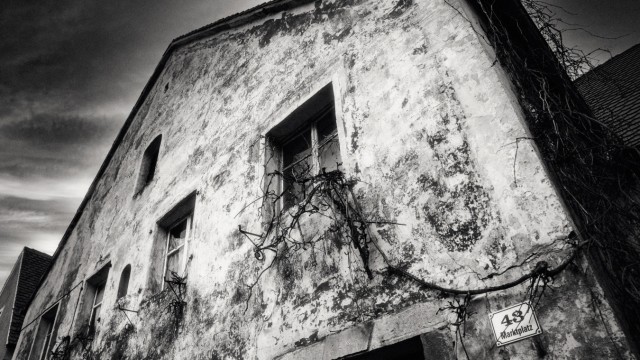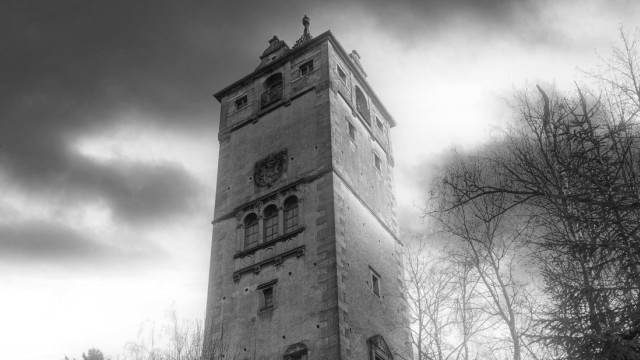Rolf Stemmle chose an ice-cold January day for his visit. North of the A3 between Regensburg and Passau he trudged through the wet grass and then, behind tall trees, he saw the tower. It stood alone, strangely intact with its paneled doors and arched windows. The last relic of a story that happened around 80 years ago. It’s about Nazis, a big fire and a secret that almost no one knew about. Neither does Rolf Stemmle. He researched and then invented a story, a personal drama based on historical truth.
That’s what they came up with at the East Bavarian Writers’ Association and the Battenberg-Gietl-Verlag from Regenstauf. Be inspired by abandoned and remote places – new German: Lost Places – and make a book out of them. They called it “Abandoned Eastern Bavaria” with lots of photos of places that hardly anyone else knows about – a crumbling house in Amberg, a Jewish cemetery near a former concentration camp, an old military training area.
The house on Hafnergässchen in Amberg has been empty since the 1970s. The walls have stood there since the Middle Ages, what could they possibly tell?
(Photo: Christian Greller/Christian Greller Photography)

The Hohenfels military training area was built in 1938, but today the buildings are weathering away.
(Photo: Christian Greller/Christian Greller Photography)
And with nineteen stories that the authors wrote around these places and thus – as Rolf Stemmle says – turned an unfinished situation into something complete.
His tower, for example. A wealthy industrialist built the New Steinach Castle at the beginning of the 20th century. After inflation he could no longer hold on to it and sold it to the “Reichsautobahn” in 1939. The castle was to become a luxury rest stop on the planned highway from Nuremberg to Vienna. That didn’t happen, the war came and with it the NSDAP came to small Steinach in Lower Bavaria. They looked for a hiding place for their party documents, first to protect them from air raids and later to hide them from the advancing Americans. So in 1943 they moved in; Martin Bormann, head of the NSDAP party office, also had an office there. Around a hundred typists worked in the secret party headquarters and were housed in Straubing as inconspicuously as possible. When the end of the war approached, they burned their archives in the castle courtyard and burned down the entire castle – except for the tower.

Only the tower remains after a fire in the New Steinach Castle in Lower Bavaria.
(Photo: Christian Greller Photography/Christian Greller Photography)
So much for the historical facts, which are summarized in a small information box before each story. That alone is a “crazy story,” says Stemmle. At least he had no idea. And tried to add a crazy story on top of it. He tells it from the perspective of the castle manager. He accommodates his nephew, a deserter who no longer wants to go to Russia in the murderous winter, in the empty castle. When the NSDAP turned his hiding place into their secret office, he was no longer able to move out and then had to live there with the fear of being discovered. At least until the big fire. The end, whether he survived or not, cannot be revealed, says Stemmle.
If you want to know, you don’t have to invest too much time. Hardly any story has more than ten pages. In addition to the Nazi hideout in Steinach, there is also a collapsed farmhouse in the Schwandorf district and the reflections that come to a budding journalist when she visits with a former resident. She philosophizes about decay, new paths and rediscovery. Other times a “grant” takes you back to the time when the Hauzenberg-Passau local railway transported granite, graphite and wood from the Bavarian Forest. At first silent, as the Woidlers are said to be, and then talkatively, he talks about his life.

The Hauzenberg-Passau railway line stood for progress at the beginning of the 20th century, and today volunteers are fighting to preserve the disused but wildly romantic line.
(Photo: Christian Greller/Christian Greller Photography)
Only one place stands out. It is far from abandoned and equally unknown: Ohu near Landshut, where the Isar II nuclear power plant is located, which was shut down this year. But the author invents a club that doesn’t want to dismantle the power plant, but wants to market it as a “lost place” and save it. And it fits into the concept again. In the end, this plan is thwarted by an unusual opponent: water. One story has fantastic parts, another brings you closer to true events through fiction. Even if a story doesn’t suit your taste, you can read it so quickly that it’s hardly worth getting annoyed.
And for everyone who not only wants to read about deserted eastern Bavaria, but also wants to experience it for themselves, there are precise location details. There shouldn’t be too many visitors. Otherwise the publisher would have to come up with a new title.
Association of German Writers Eastern Bavaria: Abandoned Eastern Bavaria. Lost Places and Forgotten Stories, Battenberg-Gietl-Verlag, 200 pages

